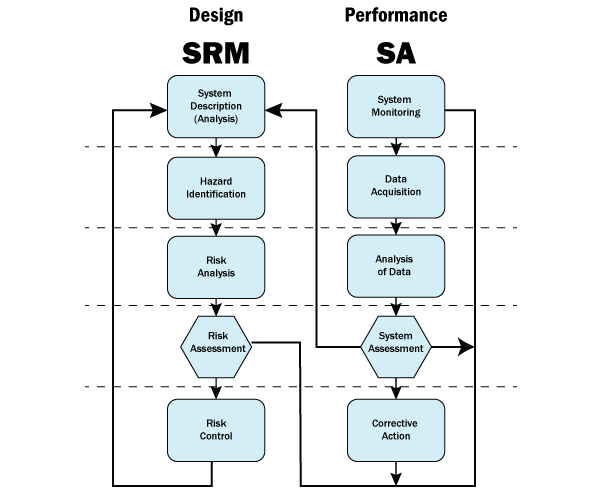Email Remains Popular for Aviation Hazard/Safety Reporting

Many aviation safety managers use email to collect hazard and safety reports. Email serves as an extremely convenient vehicle for employees and stakeholders to communicate safety concerns to safety teams. After all, most people today have access to email accounts and many carry a personal device with email capabilities in either their:
- Smart Phone; or
- Tablet.
Until recently, I believed most safety managers had effective processes to import email-reported safety hazards into their aviation safety management system (SMS) database. I was shocked to hear from two companies that were using email reporting wrong.
Are you using email hazard and safety reporting properly?
Related Aviation Safety Reporting Articles
- How to Get Employees Participating in Safety Reporting - Aviation SMS
- How to Develop Healthy Safety Reporting Cultures in Aviation SMS
- What Is Missing Most in Aviation Safety Reporting Systems?
Why Employees Are Not Reporting Hazards
One of the safety managers' biggest challenges is getting employees and stakeholders to report
- identified safety hazards;
- minor incidents; and
- close calls.
Some common reasons that employees don't report hazards or safety concerns include:
- Too difficult to access safety reporting system (cannot remember URL, username or password);
- Safety reporting system is slow;
- Safety reporting system requires too much work to fill out the required fields;
- No historic feedback from managers demonstrating the importance of previously reported issues;
- Disillusioned with the company (this is just a job, not my future);
- Distrust of management or fear of retribution;
- No indication that their reports "make a difference;" or
- Management did not adhere to the non-punitive reporting policy.
Healthy Safety Reporting Systems Have Active Participation
How do you know that you have a healthy reporting culture? If you receive one report for every ten employees each month, then your company can claim to have a healthy safety reporting culture.
I like to use the 1/10 ratio but also seen another credible ratio, which is one report per employee per year. This would equate to a 1/12 ratio or one report for every 12 employees per month.
How many safety reports does your safety reporting system take each month? Do you know? If you are the safety manager, you probably have this statistic immediately available. If your safety reporting metrics are not adequate, several activities will help. In fact, the fourth pillar (Safety Promotion) is designed to involve employees in the SMS.
High safety reporting numbers don't just happen because you suddenly have an SMS. Aviation service providers need to train employees how to:
- identify hazards;
- report hazards; and
- learn what hazards and safety concerns are important to management.
How many times have you sat in a safety meeting and the supervisor says: "All right guys. We have to watch out for x, y, and z. If you see anything suspicious or anything that doesn't look right, report it, all right?"
This would be the end of the safety promotion speech. No additional training, no examples of what other employees are reporting...pretty much nothing more. And if you were like me, I just wanted to get back to work.
Safety meetings were so boring to me when I was younger. After all, the accident wouldn't happen to me, right? Our safety culture was not good. I believed management wanted production, not real safety. Management's commitment didn't seem genuine. Maybe it was. But I didn't know it or believe it. Perceptions are very important for developing healthy safety reporting cultures.
Related Aviation Safety Culture Articles
- How Aviation Safety Managers Can Improve Safety Reporting Cultures
- 5 Simple Tips to Improve Aviation Safety Reporting Cultures
- Safety Chart: How Active Is Your Aviation Safety Reporting Culture
Reducing Friction to Safety Reporting System
An excellent way to encourage employee hazard reporting is to reduce friction in the safety reporting process as much as possible.
Keep it simple.
Don't require lengthy safety reporting forms.
You can usually follow up if necessary to acquire additional details unless the reporter wishes to remain anonymous.
The first objective should always be to "get the initial report." Email serves as a superb vehicle to get that initial report.
Most employees today have email.
Most employees today have smartphones.
Most employees will report an issue by email if:
- They are required (foot on their neck); or
- They see the value of their contributions.
Using Email Hazard Reporting the Wrong Way
Now we finally get to the point of this article. Many managers are not using email reporting properly. They are acquiring email hazard reports, but...
- Their emails sit in their inbox for days before initial actions are taken;
- Some reports are deemed as low priority and never reach the appropriate management team;
- Many reports are dealt with informally and never entered into a risk management system; and
- Some reports fall through the cracks when the primary recipient is on vacation (away on training).
At a bare minimum, reported safety issues should be distributed to at least two managers. This practice will reduce most of the identified problems above. However, there is a better way.
Best Way to Manage Email Hazard Reports

Traditionally, safety managers that use email reporting manually process the reports and enter them into their aviation risk management system. This would require:
- Create a report (in an aviation SMS database or MS Excel or Word template);
- Copy and paste the email into the database or Word template.
Once the email report is in the risk management system, then it is processed per policy, such as:
- Defining a risk statement;
- Conducting a risk analysis and assessment;
- Applying and documenting mitigation strategies (if risk assessment warrants);
- Performing an in-depth investigation (if policy warrants); and
- Closing the report and setting a next review date.
Hopefully, you are not documenting your risk management activities in spreadsheets or an MS Word template. I hope you have an aviation SMS database to save time and add some structure to the aviation SMS. An aviation SMS database is highly recommended to manage SMS documentation requirements for aviation service providers with more than 40 employees or even smaller companies that have high employee turnover.
Related Aviation SMS Database Articles
- What Is an Aviation Safety Database
- 5 Most Important Things to Know Before Buying Aviation SMS Database
- How to Choose the Best Aviation Safety Database Software
I have been seeing a lot of email and spreadsheet safety reporting systems as late as 2019. Unfortunately, this data management strategy is not sustainable for long-term SMS performance. It will work for a short-term SMS data management strategy, but there is no way to be assured that safety managers can classify and spot trends using spreadsheets.
SMS performance monitoring requires regular, active participation from both the safety manager and the accountable executive. Whenever possible, safety reporting processes should be automated to reduce risk and improve safety team efficiency. Safety teams have plenty to do without making them copy/paste data from one system to another to create charts, graphs, or perform routine risk management activities.
The best way to incorporate email reporting into the SMS data management platform is to have an automated process that captures emailed safety reports and sends out notifications after the reported safety issue enters the database.
Such a process would follow this sample workflow:
- A scheduled service would query your safety email account every five minutes;
- If a new email is sitting in the Inbox, pull the email into the database;
- After the email is converted into a reported safety issue, notify safety managers; and
- Send a "thank you" email to the reporter with a way for the reporter to track his issue.
This is a very clean way to report safety issues and to pull them automatically into the SMS database where risk management processes can be properly documented. When there is no automated process, there may be a tendency by safety managers to not import minor incidents and close calls into the SMS database. This becomes a problem with accurate trend analysis.
Predictive risk management depends on historical data to accurately analyze trends. All of these minor incidents and close calls that may seem minor are in fact VERY important. The Heinrich principle states that for every major accident, there are 600 minor accidents and close calls. Every minor incident and close call must be reported and processed appropriately, such as proper classifications applied.
Imagine that we have 100 safety reports this year for a company with 300 employees. Very nice safety reporting culture, one may think, but you now know this safety culture needs more work. Let's call this service provider "company A."
Another similar aviation service provider has 300 safety reports for a company with 300 employees. Now, this is a healthy reporting culture. We'll call this service provider "company B."
We know that company B has had more opportunities to refine its business processes than company A. Company B has more practice pushing safety concerns through a tried and proven risk management process that we see in every aviation SMS. I'm talking about safety risk management (SRM) and safety assurance (SA).

With all things being equal, which company
- should be more competitive in the marketplace?
- has a more engaged workforce?
- has more accurate trend analytics?
Email safety reporting should not be overlooked! You need to get as many safety reports as possible to put through your risk management processes.
Reduce the friction user experience reporting and get more safety reports. Email reporting should be one of your chief SMS safety assurance tools.
Related Aviation SMS Trend Analysis Articles
- Aviation Safety Managers' Best Friend - Trending Charts
- How to Use Trending Charts in Aviation SMS
- How to Prepare Data for Trend Analysis in Risk Management Programs
Final Thoughts on Email Hazard Reporting
Changing employee attitudes toward safety reporting requires persistence and consistent safety promotion activities. When employees discover that hazard and safety reporting doesn't have to be a painful exercise, they are more apt to report potential hazards to the safety team.
Safety managers can only react to observable and reported safety concerns. Line employees are in the trenches and if your safety program can capture their safety concerns, you will be on the right road toward mitigating risk and implementing corrective/preventive actions. And should I mention the future value these reports have for spotting trends?
Reduce friction to your aviation SMS. Proper SMS database tools enhance safety cultures. Don't believe me? How many people have told you that they like the FAA's WBAT safety reporting system? WBAT is perhaps one of the biggest safety culture detractors in the United States. When employees and managers don't like a system, they won't use it.
If you are using WBAT, you don't have to suffer. Other operators have ditched WBAT in favor of SMS Pro, which is a complete SMS database.
Since 2007, we have been providing the best aviation SMS database software on the market. Each day, I become more confident that SMS Pro is the best database software because our clients have been repeating this same story for years. I'm beginning to believe them.
Do you need good aviation SMS database tools? We want to be your SMS Partner. Watch these short demo videos to learn whether we are a good fit for you.
Last updated April 2025.






